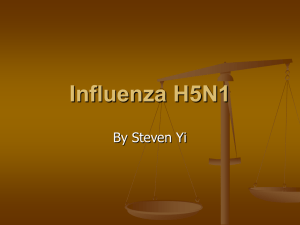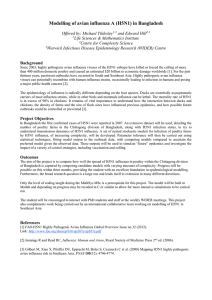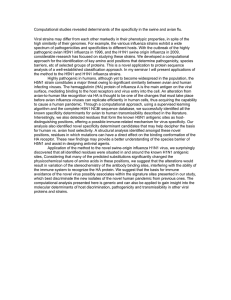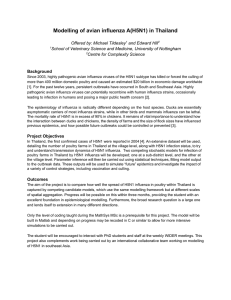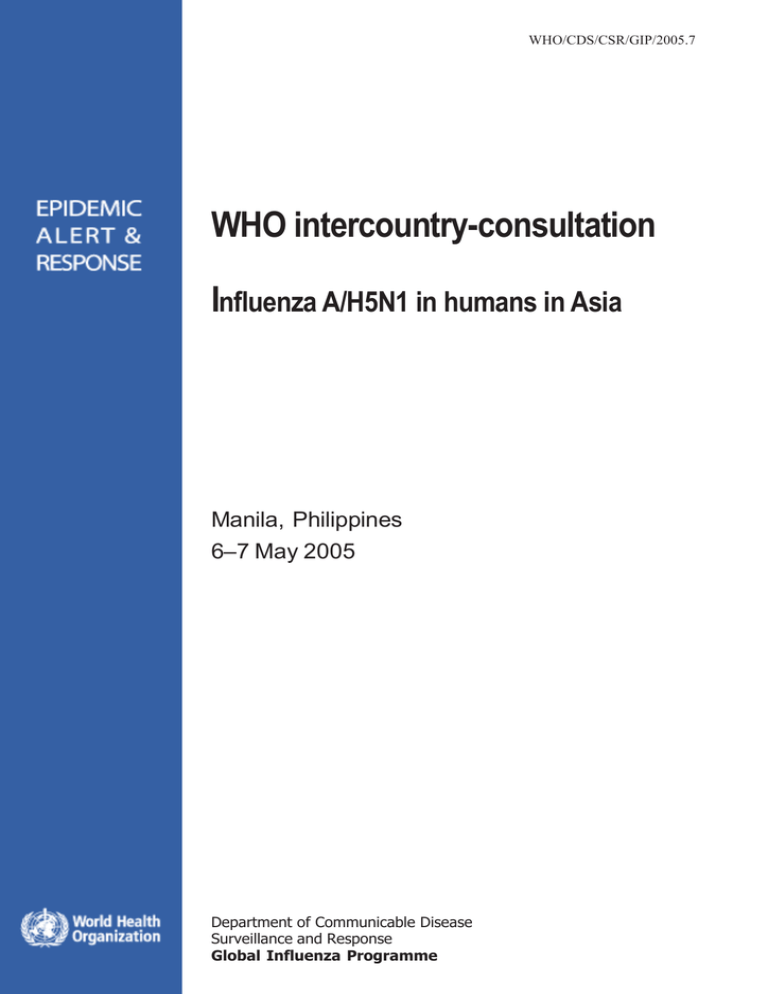
WHO/CDS/CSR/GIP/2005.7
WHO intercountry-consultation
Influenza A/H5N1 in humans in Asia
Manila, Philippines
6–7 May 2005
Department of Communicable Disease
Surveillance and Response
Global Influenza Programme
© World Health Organization 2005
All rights reserved.
The designations employed and the presentation of the material in this publication do not imply the
expression of any opinion whatsoever on the part of the World Health Organization concerning the legal
status of any country, territory, city or area or of its authorities, or concerning the delimitation of its
frontiers or boundaries. Dotted lines on maps represent approximate border lines for which there may
not yet be full agreement.
The mention of specific companies or of certain manufacturers’ products does not imply that they are
endorsed or recommended by the World Health Organization in preference to others of a similar nature
that are not mentioned. Errors and omissions excepted, the names of proprietary products are distinguished by initial capital letters.
All reasonable precautions have been taken by the World Health Organization to verify the information
contained in this publication. However, the published material is being distributed without warranty of
any kind, either express or implied. The responsibility for the interpretation and use of the material lies
with the reader. In no event shall the World Health Organization be liable for damages arising from its
use.
WHO intercountry consultation. Influenza A/H5N1 in humans in Asia.
Manila, Philippines, 6–7 May 2005
ASSESSMENT
Some important epidemiological features of human H5N1 infections occurred in northern Viet Nam
during January through April 2005 and appeared to differ in some respects from those seen in 2004 in
other parts of Asia, and in the concurrent period in southern Viet Nam. These included an increase in
the number of case clusters in the north compared with the south, a prolonged interval between the first
and last cases in clusters, detection of sub-clinical infections, an expanded age range of cases and
fewer fatal cases. Investigators were not able to prove that human-to-human transmission had
occurred. However they expressed concerns, which were shared by local clinicians, that the pattern of
disease appeared to have changed in a manner consistent with this possibility.
These differences suggest that the epidemiology of H5N1 infections may be evolving in Asia. The
changes in epidemiological patterns are consistent with the possibility that recently emerging H5N1
viruses may be more infectious for humans. Furthermore, sequencing analyses of H5N1 genes from
avian and human H5N1 viruses from several countries suggest that they are becoming more
antigenically diverse and may be forming distinguishable groupings based on phylogenetic analyses.
While the implications of these epidemiological and virological findings are not fully clear, they
demonstrate that the viruses are continuing to evolve and pose a continuing and potentially growing
pandemic threat. Based on these concerns and findings, it would be prudent to take increased steps to
improve risk assessment procedures, to strengthen the ability of affected countries to respond promptly
to local outbreaks, to accelerate control of avian influenza in poultry and to implement or complete
pandemic preparatory actions as soon as is possible, even if current H5N1 outbreaks in Asia cease or
diminish during the summer.
1.
Background
Since late 2003, avian influenza A (H5N1) virus infections in Asia have resulted in the death or culling
of more than 100 million poultry. In addition, H5N1 viruses have repeatedly “jumped the species
barrier,” and infected (as of 5 May 2005) at least 92 adults and children in Cambodia, Thailand and
Viet Nam, resulting in 52 deaths (57%). Despite this already considerable impact, H5N1 viruses have
the potential to cause far greater harm if they evolve and gain the ability to easily infect and transmit
among people. An H5N1 virus with this ability could lead to a global pandemic and many millions of
deaths worldwide. So far, most human infections have occurred sporadically, but clusters of infections
predominantly affecting household members have occurred in Thailand and Viet Nam and, most
likely, Cambodia. Most human H5N1 infections so far are thought to have occurred through some
form of contact with live or dead infected poultry but isolated instances of probable person-to-person
transmission were documented in Hong Kong in 1997, in Thailand in 2004, and cannot be excluded in
some of the Cambodian or the recent and earlier clusters in Viet Nam. The affected countries have
already responded to the emergence of H5N1. The Expert Consultation was impressed with a number
of the actions taken including the establishment of national multisectoral control committees
(Viet Nam), thorough investigation of potential clusters (Cambodia) and close collaboration between
the agricultural and human health sectors (Thailand).
–1–
WHO intercountry consultation. Influenza A/H5N1 in humans in Asia.
Manila, Philippines, 6–7 May 2005
Since the first H5N1 outbreak in Hong Kong SAR in 1997, regional and international public health
authorities have monitored H5N1 viruses to identify viral or epidemiological changes possibly
signifying that the virus has become significantly more infectious for people and therefore closer to
causing a pandemic. However, the task of identifying such changes is complicated. Evolution of a
pandemic strain of virus may be preceded by numerous small steps, none of which is sufficient to
signal clearly that a pandemic is about to start. This poses a difficult public health dilemma. If public
health authorities move too soon, then unnecessary and costly actions may be taken. However, if
action is delayed until there is unmistakable evidence that the virus has become sufficiently
transmissible among people to allow a pandemic to develop, then it most likely will be too late to
implement effective focal, national or regional responses, and opportunities will be missed to “Get
Ahead of the Curve” and prevent large numbers of infections and deaths.
During 15 – 25 April, 2005, a WHO team of expert consultants was invited by the authorities in
Viet Nam to assess the current H5N1 situation, especially in northern Viet Nam. Based on the
epidemiological information presented, this team concluded that the epidemiology of H5N1 could be
changing in that part of the country and that the risk for pandemic influenza could have risen.
Therefore a second urgent Expert Consultation was held involving a group of epidemiologists,
virologists, public health and animal health experts with international experience, and country
representatives from Cambodia, Thailand, and Viet Nam. Its objectives were to review the current
situation of the A/H5N1 in humans in Asia and provide an overview on the current risk for an
influenza pandemic and in the light of this to identify priorities for continued international
collaboration on situation assessment and pandemic preparedness. This assessment was held at the
WHO regional office in the Western Pacific (WPRO) in Manila during 6–7 May, 2005. Presentations
were made by representatives of the three countries that provided information on the epidemiological,
clinical and virological findings related to human and animal H5N1 infections. In addition, information
was made available from other Asian countries along with new data and analyses from the WHO
Global Influenza Network. The three countries also summarized their extensive plans and actions in
preparation for outbreaks of H5N1 and their programmes for pandemic preparedness.
2.
Supporting Information for the Assessment
2.1
Supporting epidemiological observations – Human H5N1 infections in
northern Viet Nam 2005
•
More clusters have occurred in the north (8) than in southern Viet Nam (2). Small clusters,
observed prior to 2005, were reported by Cambodian and Thailand representatives.
•
The most recent clusters span longer time periods (i.e., took place over more days) (cf 2004)
raising the possibility that the more recent clusters may reflect a mixture of transmission
modes, including exposure to ill birds, environmental transmission, prolonged exposure to
asymptomatic birds that are shedding virus, or person-to-person transmission.
•
Between 2004 and 2005, the average age of people infected rose from 17 years to ~31 years
but remained almost unchanged (~15 years to ~18 years) in southern Viet Nam. In addition,
the age range of people infected by H5N1 has broadened and now extends from those < 1 year
to >80 years while in southern Viet Nam, the range is 2 years to under 40 years. The age range
was 2 – 58 years in wave 1 (median 12 years) in Thailand and in Cambodia, the range has
been 8 – 28 years (median 20 years).
•
The observed case fatality rate has declined to 34% (16/47) but is 83.3% (20/24) in southern
Viet Nam. The case fatality rate in Thailand was 71% (12/17) and 100% in Cambodia (4/4) in
2004.
–2–
WHO intercountry consultation. Influenza A/H5N1 in humans in Asia.
Manila, Philippines, 6–7 May 2005
•
2.2
Three asymptomatic infections have been documented among close contacts of confirmed
cases in Viet Nam suggesting that milder H5N1 infections are occurring. Four persons who
culled H5N1 infected birds in Japan and two animal attendants caring for infected tigers in
Thailand also have antibodies to H5 virus. Asymptomatic infections were also detected
retrospectively in Hong Kong following the 1997 outbreak.
Supporting viral observations
•
In general, H5N1 viruses isolated during 2004 from humans with severe respiratory infections
were very similar to avian isolates from the same country, both genetically and antigenically.
H5N1 human and avian viruses isolated in the Indochina peninsula (Cambodia, Lao People's
Democratic Republic, Malaysia, Thailand and Viet Nam) tightly clustered within clade 1,
while H5N1 viruses isolated from birds in China, Indonesia, Japan and the Republic of Korea
belonged in a second clade which showed greater genetic divergence.
•
The HA gene of viruses isolated from humans in Viet Nam in the first 3 months of 2005
showed several amino acid changes relative to 2004 viruses. None of the changes in the HA
were common to all of the 2005 viruses analysed so far. However, the most commonly
observed changes are located close to the receptor binding site and could potentially modulate
receptor binding specificity. Recent viruses circulating in northern Viet Nam have lost an
arginine residue in the mutibasic amino cluster at the proteolytic cleavage site of the HA
protein. It does not seem to be responsible for reduced pathogenicity since the structure of the
cleavage site still remains typical of highly pathogenic viruses. However at this time these are
possibilities that have yet to be further investigated by analysing more viruses.
•
Phylogenetic analysis of all H5N1 human isolates along with a subset of avian viruses from
clade 1 isolated during 2004 and 2005 in Cambodia, Thailand and Viet Nam indicates that the
viruses from Thailand and northern Viet Nam have begun to form a somewhat separate cluster
from viruses isolated from Cambodia and southern Viet Nam. As of yet, the ‘bootstrap’ values
(which provides a measure of certainty with which clades can be accurately separated) are low
due a lack of data. Sequences from additional viruses from the northern and southern regions
of Viet Nam would add statistical power to the phylogenetic analysis.
•
H5N1 human isolates from Viet Nam in 2005 are somewhat antigenically heterogeneous . In
particular, A/Viet Nam/JPHN3021/2005 is antigenically distinct from the 2004 reference/
vaccine strains A/VN/1203/04 and A/VN/1904/04. Other 2005 H5N1 human isolates exhibit
more antigenic heterogeneity than did those isolated in 2004.
•
Sequence analysis of NA genes and neuraminidase inhibitor susceptibility testing of H5N1
human 2005 isolates from Viet Nam has also revealed that one virus (A/VN/HN30408/05) has
a “mixed” virus population of amino acid residues 274-H (wild-type) and 274-Y (resistant)
sequences. Although this virus does not exhibit a fully resistant phenotype, the IC50 value for
oseltamivir® is shifted upward and consequently this virus is less susceptible to oseltamivir ®
than other H5N1 isolates tested. The patient from whom this virus was isolated had been/was
being treated with oseltamivir®. The community emergence and spread of viruses resistant to
oseltamivir®, if it were to occur, would have significant implications for influenza A/H5N1
prevention and control.
In summary, analysis of the virologic data has identified trends in phenotypic and genotypic properties
of 2005 human isolates that must be examined more closely using additional recent human and avian
H5N1 isolates. It is essential that avian and human isolates are included and compared to determine if
the 2005 viruses isolated from humans simply reflect the genetic and antigenic diversity found among
H5N1 viruses obtained from poultry or if viruses isolated from humans are beginning to exhibit
antigenic drift from avian viruses. The latter pattern would be of major concern since it would likely
indicate that a higher level of human-to-human transmission is occurring. Finally, while the antigenic
–3–
WHO intercountry consultation. Influenza A/H5N1 in humans in Asia.
Manila, Philippines, 6–7 May 2005
and genetic data indicate that the 2005 human isolates are drifting antigenically and genetically from
their 2004 predecessors and the H5N1 viruses isolated from the northern and southern parts of
Viet Nam tend to fall into different groups, there is no direct evidence to date that these changes can be
correlated with apparent changes in disease patterns between the north and the south. Additional data
from 2005 human and avian H5N1 isolates must be obtained and analysed together with data from
older H5N1 viruses.
3.
Discussion of the findings
There are several plausible interpretations of the apparent changes in epidemiological patterns of
H5N1 virus infections and the Expert Consultation considered all of these.
3.1
The changes could be artefactual or inconsequential
1. It is possible that the apparently new epidemiological patterns could simply reflect random
variation in the data since the number of cases is relatively small. This was considered unlikely
since the changes were all consistent with the avian virus possibly adapting to a human host.
2. It is possible that changes in surveillance or laboratory testing methods have created changes
that are more apparent than real. However, no significant changes in methods to identify,
report or investigate suspected H5N1 cases are known to have been made in Viet Nam since
last year that could account for the changes.
3.2
The changes could be significant
1. It is possible that the avian H5N1 viruses are becoming more infectious for people, facilitating
infection in a greater number or range of people and resulting in more clusters. It might not be
that this led to human to human transmission.
2. It is possible that avian H5N1 viruses are becoming more capable of human-to-human
transmission.
3. It is possible that there is a change in exposures or behaviours placing people at risk for
infection. For example direct touching of poultry or poultry faeces contaminated surfaces,
eating uncooked poultry products (e.g., blood) or preparing poultry have been considered the
probable routes of exposure leading to infection in most older children and adults. However,
infections of children <1 year are more difficult to explain by these exposures and raise other
possibilities such as contact with contaminated household surfaces, or eating or drinking
contaminated water or food, or possibly through direct transmission from another person.
4. It is possible that changes among people reflect an increase in transmission from asymptomatic
but infectious poultry. It was noted that some human clusters were detected before cases were
found in poultry, which also suggests inadequate surveillance or under-reporting of avian
infection or disease in poultry. Therefore, current comparisons of disease prevalence in
poultry between countries and even parts of one country may not be valid. In addition,
significant percentages of ducks can shed virus while remaining asymptomatic. However, if
this is true, then it suggests that epidemiology among birds in the north is diverging from
patterns in the south and would not explain why relatively fewer people appear to be acquiring
infections in the south where avian poultry infections (including ducks) have remained
generally high or why more clusters have been reported from the north.
–4–
WHO intercountry consultation. Influenza A/H5N1 in humans in Asia.
Manila, Philippines, 6–7 May 2005
5. It is possible that the widening age range reflects increasing persistence of the virus in local
environments providing more chances for more people of all ages to become exposed and
infected. However, this would not address the apparent divergence in patterns in the north and
south.
4.
Recommendations
The recommendations followed directly from the Expert Consultation’s assessment process. They
reflect both the difficulties that were experienced in reaching a clearer assessment because of a relative
lack of relevant information as well as recommendations for immediate actions that reflect the higher
level of concern about the possibility of pandemic influenza, based on the assessment.
4.1
Related to the Assessment
Immediate steps should be taken to improve the ability to monitor and assess the risk for pandemic
influenza more rapidly, continuously and completely in all countries where avian H5N1 viruses are
present. Specifically:
•
WHO should continue to mobilize technical assistance as needed and requested by affected
countries.
•
All relevant data should routinely be made available for review by the WHO Pandemic Task
Force which should now be convened by WHO to meet regularly to assess the risk for
pandemic influenza.
•
Animal and human health sectors, at every level from FAO/OIE/WHO down to the local level,
should coordinate their approaches to epidemiological, virological and clinical surveillance
across specialties. The coordination should lead to regular, timely and meaningful exchange of
information and plans.
•
WHO should coordinate with FAO, OIE and key agricultural, public health and private sector
partners to develop a mechanism through which detailed information on the genetic and
antigenic characterization of animal and human influenza H5N1 viruses, and the viruses
themselves, can be exchanged more freely and rapidly between laboratories and among
countries. Information should flow in both directions. The need is especially urgent for
ongoing information on the genetic and antigenic makeup of recent isolates of H5N1 viruses
from poultry, other birds and animals and people across Asia to facilitate comparisons of
H5N1 viruses detected in humans and poultry.
•
Surveillance for human H5N1 infections should include identification and characterization of
clusters of suspected and confirmed H5N1 infections including in returning travellers from
risk areas.
•
WHO should, as a priority, complete the development of its handbook on the approach to
investigating possible H5N1 clusters.
•
Countries and individual researchers should urgently analyse and disseminate information that
has already been collected on H5N1 viruses and related activities.
–5–
WHO intercountry consultation. Influenza A/H5N1 in humans in Asia.
Manila, Philippines, 6–7 May 2005
4.2
Related to pandemic preparedness
•
All countries, both those affected and unaffected by avian H5N1, and with the assistance of
WHO and other agencies as needed, should move ahead as quickly as possible and develop or
finalize practical operational pandemic preparedness plans.
•
WHO should continue to explore and develop international approaches that can be used to
reduce the threat or impact of pandemic influenza including an international stockpile of
antiviral drugs from which supplies can be very rapidly provided for use in control of an
outbreak of human H5N1 infection that threatens to spread beyond its initial confines.
•
Further exercises should be undertaken by individual countries, with the assistance of WHO as
needed to rehearse the early and rapid responses to early outbreaks including deployment of
the stockpile.
•
WHO should explore all possible mechanisms for making human H5N1 vaccine available to
affected countries in Asia before the start of a pandemic by bringing together technical experts,
countries, manufacturers and potential donors to establish the feasibility of increasing global
H5N1 vaccine production. This should include an assessment of the need for a new vaccine
seed strain if recent isolates are genetically and antigenically distinct.
4.3
Related to control of avian influenza
•
4.4
It was observed that in places where infection in poultry has been controlled or eliminated,
human cases no longer occur. In the current period, prevention of H5N1 avian influenza in
humans is best achieved by controlling infection in poultry. As already recommended by FAO
and OIE, control strategies for this disease should consider vaccination of poultry, which has
been used successfully before. Evidence to date suggests that the index case in most of the
human clusters in Viet Nam occurred after exposure to infected poultry, indicating that the
disease is still a zoonotic infection.
Related to funding
•
Countries requiring external funds to enhance their technical capacity to address H5N1
infections and other emerging disease threats should coordinate and prioritize the national
needs of agricultural and public health sectors and provide this information to WHO and
donors to facilitate the funding process.
•
International funding agencies should coordinate their efforts to minimize any redundant and
duplicate funding of activities and to eliminate gaps. Support should be given to capacity
building as well as urgent or emergency solutions and should target broader emerging
infections and general needs for controlling endemic diseases as well as influenza. Agencies
supporting development should be specifically approached by countries and WHO because of
the potentially profound implications for health security, social and economic development
regionally and worldwide from a pandemic.
–6–
WHO intercountry consultation. Influenza A/H5N1 in humans in Asia.
Manila, Philippines, 6–7 May 2005
List of participants
1. Participants
South-East Asia Region (SEAR)
Thailand
Dr Supamit Chunsuttiwat
Senior Expert in Prevention Medicine
Department of Disease Control, Ministry of Public Health, Nonthaburi, Thailand
Dr Woraya Luang-On
Medical Officer, Bureau of General Communicable Diseases, Department of Disease Control Ministry
of Public Health, Nonthaburi, Thailand
Dr Orapan Pasavorakul
Senior Veterinary Officer, Head, Sub-Division of Veterinary Epidemiology, Bureau of Disease
Control and Veterinary Services, Department of Livestock Development, Bangkok, Thailand
Western Pacific Region (WPR)
Cambodia
Dr Ly Sovann
Head of Disease Surveillance Bureau, Department of Communicable Disease Control, Ministry of
Health, Phnom Penh, Cambodia
Viet Nam
Dr Phan Trong Lan
Unit of Epidemiology, General Department of Preventive Medicine and HIV/AIDS, Ministry of Health
Ha Noi, Viet Nam
Professor Pham Ngoc Dinh
Deputy-Director, National Institute of Hygiene and Epidemiology (NIHE), Ha Noi, Viet Nam
–7–
WHO intercountry consultation. Influenza A/H5N1 in humans in Asia.
Manila, Philippines, 6–7 May 2005
2. Temporary advisers
Dr Bruce Armstrong
Head, School of Public Health, The University of Sydney, Sydney, Australia
Dr Nancy Cox
Centers for Disease Control and Prevention, Atlanta, United States of America
Dr Keiji Fukudan
Rickettsial Diseases, Influenza Branch, Centers for Disease Control and Prevention, Atlanta,
United States of America
Dr Fred Hayden
Internal Medicine and Pathology, Health Sciences Center, University of Virginia, Charlottesville,
United States of America
Professor Angus Nicoll
Director, Communicable Disease Surveillance Centre, Health Protection Agency, Communicable
Disease Surveillance Centre, London, United Kingdom
Dr Leslie Sims
OIE/FAO Consultant, Asia Pacific Veterinary Information Services, Manunda, Australia
Dr Masato Tashiro
Director, WHO Collaborating Centre for Reference and Research on Influenza, Department of
Virology III, National Institute of Infectious Disease, Tokyo, Japan
3. Secretariat
WHO/HQ
Dr Guenaël Rodier
Director, Communicable Disease Surveillance and Response, CDS/CSR, World Health Organization
Geneva, Switzerland
Dr Klaus Stöhr
Team Coordinator, WHO Global Influenza Programme, Department for Communicable Disease
Surveillance and Response, World Health Organization, Geneva, Switzerland
Dr Alice Croisier
Medical Officer, WHO Global Influenza Programme, Department for Communicable Disease
Surveillance and Response, World Health Organization, Geneva, Switzerland
Dr Michael Perdue
Medical Officer, WHO Global Influenza Programme, Department for Communicable Disease
Surveillance and Response, World Health Organization, Geneva, Switzerland
–8–
WHO intercountry consultation. Influenza A/H5N1 in humans in Asia.
Manila, Philippines, 6–7 May 2005
WHO/WPRO
Dr Richard Nesbit
Director, Programme Management, World Health Organization, Regional Office for the Western
Pacific, Manila, Philippines
Dato' Dr Tee Ah Sian
Director Division, Combating Communicable Diseases, World Health Organization, Regional Office
for the Western Pacific, Manila, Philippines
Dr Hitoshi Oshitani (Responsible Officer)
Regional Adviser, Communicable Disease Surveillance and Response, World Health Organization
Regional Office for the Western Pacific, Manila, Philippines
Dr Li Ailan
Medical Officer, Communicable Disease Surveillance and Response, World Health Organization,
Regional Office for the Western Pacific, Manila, Philippines
Dr Richard Brown
Epidemiologist, Communicable Disease Surveillance and Response, World Health Organization,
Regional Office for the Western Pacific, Manila, Philippines
Dr Peter Horby
Medical Epidemiologist, Communicable Disease Surveillance and Response, Office of the WHO
Representative in Viet Nam, Ha Noi, Viet Nam
Dr Megge Miller
Epidemiologist, Communicable Disease Surveillance and Response, Office of the WHO
Representative in Cambodia, Phnom Penh, Cambodia
–9–


